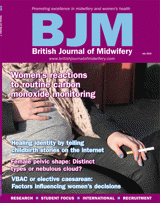References
Creating a culture of ‘safe normality’: Developing a new inner city alongside midwifery unit
Abstract
Objective:
To investigate how midwives and midwifery managers were attempting to provide choice for women, through the creation of a service with a distinct culture from the obstetric unit (OU) prior to the opening of a new alongside midwifery unit (AMU).
Methods:
Fifteen purposively sampled midwives and midwifery managers from three practitioner groups: prospective birth centre midwives, obstetric unit midwives and midwifery managers involved in the AMU set-up were interviewed using semi-structured interviews.
Results:
Through the development of the AMU, staff perceive that low-risk women will be provided with a choice of ‘safe normality’ for their birthing experience. Staff are attempting to create a culture of care that is distinct from the OU while still benefiting from the perceived safety of close proximity medicalised care. This distinct culture is being created through the choice of an AMU over other alternatives; the design of the AMU and the environment created; and the selection of appropriate staff that have competence and confidence in their ability to deliver women-led care. However, there is a risk that the distinct culture of care may be in jeopardy due to the blurring of boundaries between the AMU and OU. This is partly as a result of the practical issues associated with a case mix skewed towards high-risk women in a deprived inner city context and the strong belief by OU midwives that ‘safe normality’ is already available within the OU.
Conclusions:
The AMU appeals strongly to the perceptions of midwives and midwifery managers as providing good quality midwife-led care and a safe place of birth that offers choice that will be accepted by the women they care for.
In the UK, the majority of maternity care is provided through obstetric units (OUs) (accounting for approximately 93% of births). The remainder of births taking place at home (2%); within stand-alone midwifery units—located on a site away from obstetric services in a nearby town or with other community or acute health services (2%); or within alongside midwifery units (AMUs) located in, or on the same site as a hospital to provide quick access to anaesthetic, obstetric and neonatal services where required (3%) (Healthcare Commission, 2008). OU care is provided by both midwives and obstetricians, with the latter taking lead responsibility for women who are at a higher risk in pregnancy and birth. There has been concern for a number of years that OUs continue to over-medicalise birth. This can result in unnecessary intervention and lower satisfaction with the birth experience by women and their partners—commonly termed the ‘medical model of care’ (Newburn, 2010).
Register now to continue reading
Thank you for visiting British Journal of Midwifery and reading some of our peer-reviewed resources for midwives. To read more, please register today. You’ll enjoy the following great benefits:
What's included
-
Limited access to our clinical or professional articles
-
New content and clinical newsletter updates each month

